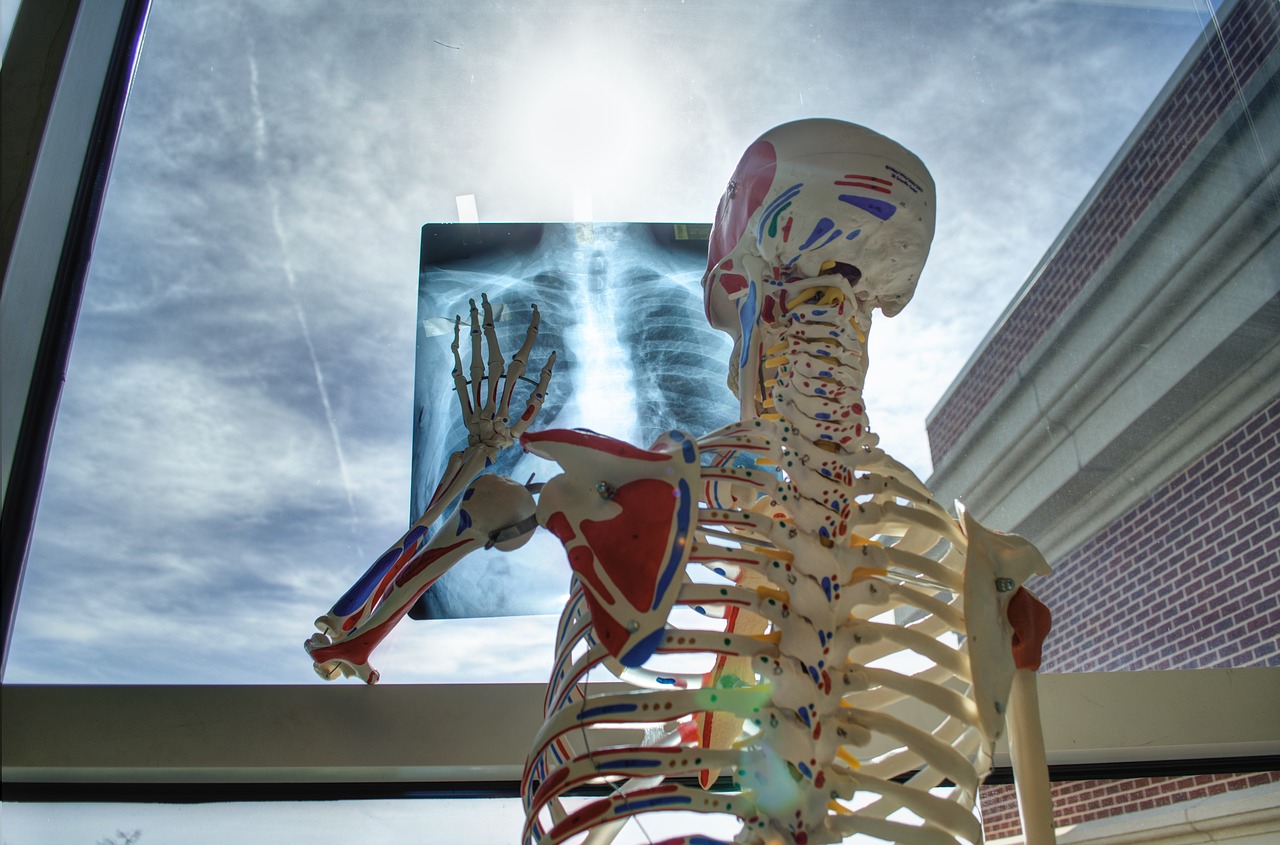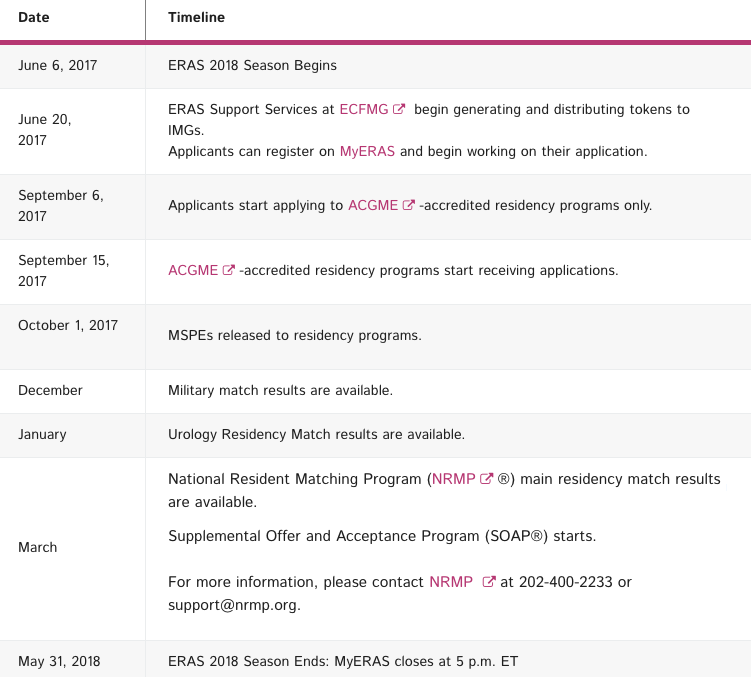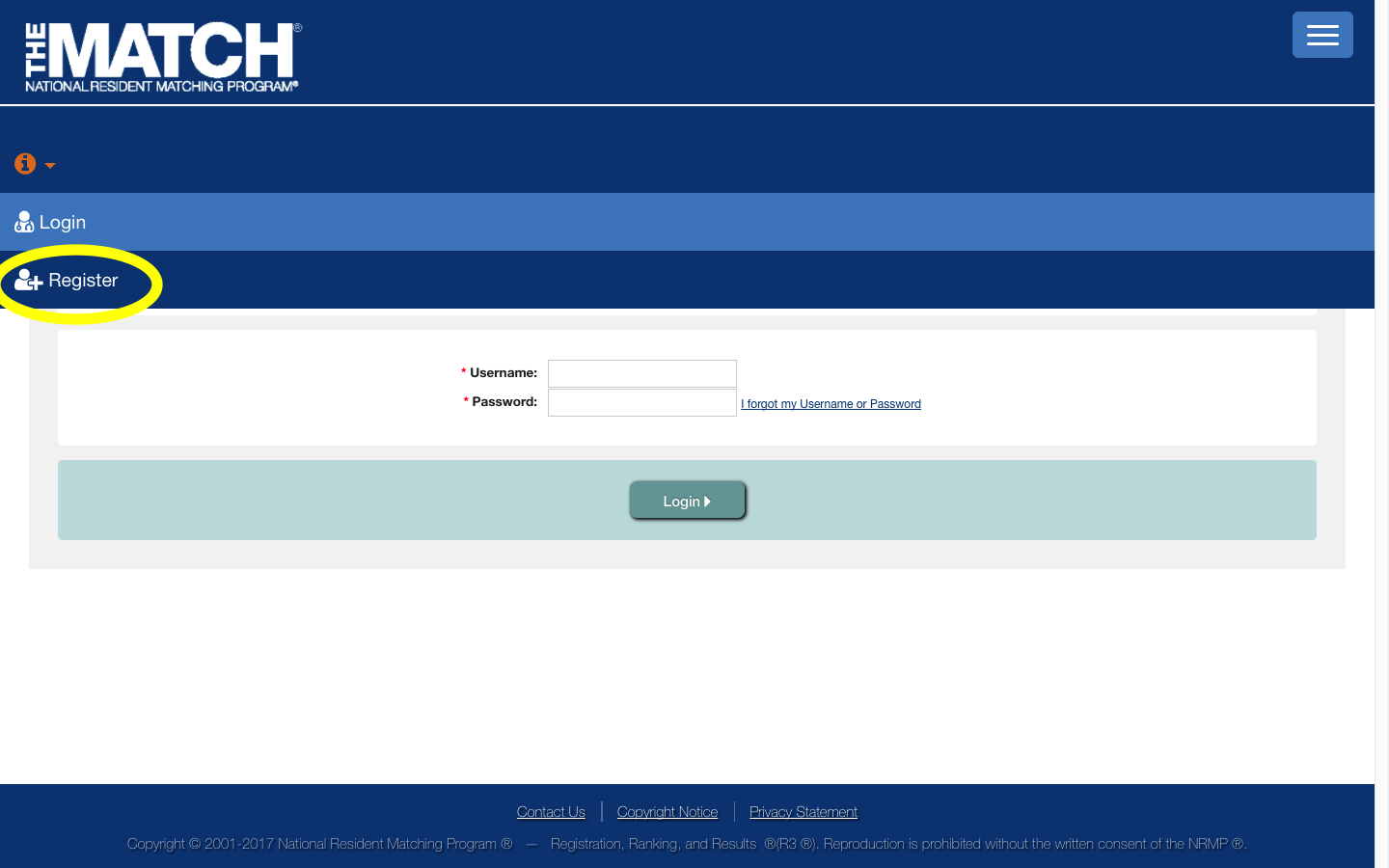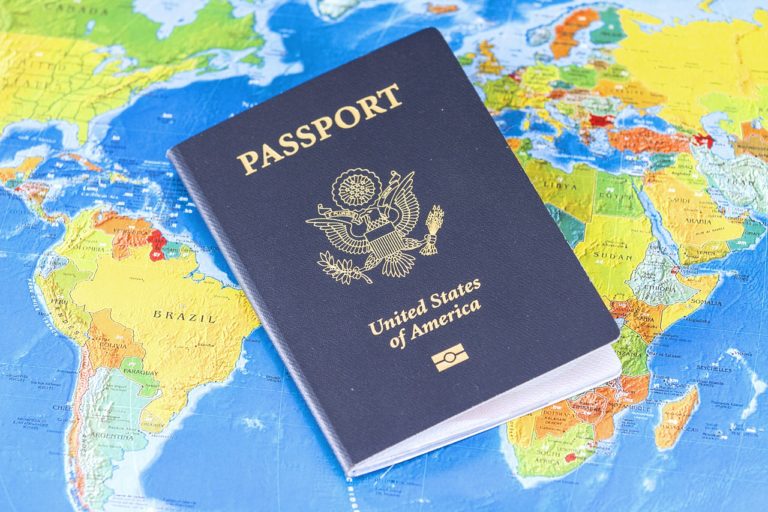The process of applying for residency in the United States is the final step of that long and arduous road to get that training position of our dream. In this post, I will explain the confusing process of “Application for Medical Residency via ERAS” for International Medical Graduates (IMG’s). Definitely, this is not the final step we will need to make in our careers, but it is one of the major ones. Ideally, before applying we should try to finish our USMLE examinations, ECFMG certification (if applicable), the United States clinical experience (USCE), letters of recommendation (LoR’s), personal statement, and others I will explain in detail later on.
It is crucial to understand the application process from the official resources such as:
- USMLE United States Medical Licensing Examinations
- ECFMG Educational Commission for Foreign Medical Graduates
- Association of American Medical Colleges AAMC
Furthermore, it is very important to get familiar with the ERAS user guide for residency:
First of all, it is vital to recognize the timeline for the entire process so that we can do everything promptly. Every year, the Association of American Medical Colleges (AAMC) publishes the timeline for the next season. This timeline can be used to plan ahead and start preparing the necessary documentation and requirements for applying. Here we can visualize the timeline for the ERAS 2018 season:
As we can note, the process is very long and takes months. Even though it seems that we will have a lot of time for preparing, please, try to start as early as possible because “time sure flies”. The overall process for applying can be summarized in the following steps:
- ERAS Token request (ECFMG).
- Filling the ERAS application.
- ERAS application submission.
- NRMP application.
1. ECFMG ERAS Token request.
The token is a 14-digit code that will allow us to enter in the ERAS application program before September 6th (when ERAS opens the application date for ACGME accredited programs). The reason why we should ask for this token is that the application may take a while to fill out and prepare. Having the chance to enter in this program and start preparing our data is very convenient. Asking for it is quite simple and it can be done on the ECFMG website. The main steps are as follows:
- Go to ecfmg.org
- Enter in your ECFMG – OASIS website.
- Inside the OASIS dashboard, go to the left column and select the option at the bottom called “ERAS support services”.
- In the next page, we select “ERAS Token request” and select the one that we need: residency or fellowship token.
- Read carefully the indications in the next page and after you have fully understood them we select confirm and we will get the code which we can copy and paste in our AAMC account.
- Next, we open our AAMC account it will show an option that says: “register token”. In case we do not have one, we can create it easily on the AAMC website: Association of American Medical Colleges AAMC.
- Paste the token code in your account. Again, read carefully the politics and protocols of AAMC and ERAS. Once we have done it, click “I agree” and it will give you access to start filling your application.
2. MyERAS: Filling the application and submitting the supporting documents.
After getting access to the ERAS application AAMC website, we can start preparing our application. On the website dashboard, we will see a list of items to complete. We must remember that the data that we are entering for now is preliminary, therefore, it will not be sent to the programs until we click the “verify and apply” option. Feel free to write your information as best as you can knowing that you will be able to change whatever is necessary. The “verify and apply” option will be available to select only when the application season is opened by ERAS (usually on September 6). The main three parts of the “Application to Medical Residency via ERAS” are:
a) Application:
- Personal information.
- Biographic information.
- Education.
- Experience.
- Licensure.
- Publications.
b) Documents:
- Letters of recommendation (LOR’s).
- Personal Statement.
- Medical School Transcript.
- Medical School Performance Evaluation (formerly called “Dean’s letter”).
- ECFMG Status report.
- Photo.
c) Programs:
- Search for programs
- Saved programs.
- Programs applied to.
Disclaimer: Before continuing, please use this information as a guide for your application preparation. In case of doubt, contact ERAS or ECFMG directly to assure that the data you are entering is accurate. We cannot take responsibility for the inadequate data entry that can occur since every application is unique and personal.
a) APPLICATION: How to fill out application step by step:
1. Personal information: It is very important to review carefully all the data that we enter in the application.
- First name: Type your name exactly as written in your official and current ID. The same name should be the one registered in your important records like ECFMG and AAMC accounts. Usually, it should be the name exactly as it appears in our official ID, for example, a passport.
- Middle name: If applicable.
- Last name: Same as the first name indications.
- Suffix: Choose the one that you feel is adequate for you, even though we can leave it without modification.
- Preferred name: Optional for helping programs to know how you would like to be addressed.
- Last 4 digits of SSN: If applicable.
- Email: Generally it will be already written since we created an AAMC account before with our email, but we can change it if we feel it is necessary. It is important to choose an email account that is readily accessible for us.
- Address: Our current address.
- Permanent mailing address: Choose yes if it is the same as your current address, otherwise indicate which is your permanent residence address.
- Citizenship information: Select the citizenship and visa status if applicable.
- Visa sponsorship needed: Indicate the type of visa you would like to get for your residency. We can choose from two options: J1 (student exchange visa) or H1B visa (work visa). If we are interested in either of the two types of visa, select both of them. Remember that, in order for being eligible for an H1B visa, the USMLE Step 3 exam must have been taken (the timeline is variable depending on the program preference).
- If residing in the United States or Canada: Indicate the state or province.
- Información de MATCH: Select “I plan to participate in the NRMP match”. It is very important to understand that the application for the NRMP MATCH Residency season is separate than the ERAS application which is the one that we are describing. The explanation about the application to NRMP will be described in this post afterward. Once we have our NRMP ID after registering for the MATCH, we will come back to type our provided ID. It is fine to leave it blank, and something even more important is to consider that it is not mandatory to have the NRMP ID in order to apply to the programs in September using the ERAS common application website. We can update this information after the application since the NRMP registration opens on September 15 at 12:00 pm. If you are applying as a couple, please indicate that here as well.
- Urology MATCH: enter your AUA Member number.
- USMLE/ECFMG ID number: Our ECFMG ID, which is the one we have used for applying to the USMLE exams and ECFMG certification.
- ACLS, BLS, PALS certification: If applicable.
- AOA y Gold Humanism Honor Society: If applicable.
2. Biographic information:
- Gender: Select if you desire to since it is not mandatory.
- Birthplace: City and country.
- Birthdate: month/day/year.
- Self-identity: We can select the ethnicity we believe we belong to. Not mandatory.
- Language fluency: We can select the option that suits more the actual English proficiency from the options provided: basic, regular, good, advanced, and native. It is better to be sincere about our English proficiency since it will be proven during the interviews. We should also indicate our primary language selecting it and choosing the option “native”.
- Military service obligation or deferment: Yes or no.
- Hobbies & Interests: Perhaps the more important part of this section, since it is the one that can describe us outside of the medical world. It is very important to write something interesting about us. Be creative. This section can help you to make a difference with other candidates. The character limit is 510.
3. Education:
- Higher education: For International Medical Graduates, the adequate option will be none, unless you have been trained in a fellowship or done a higher education degree. Our previous degrees before medical school are not the same as in the United States system, this is the reason why it is better to leave this blank (this is explained in the ERAS residency guide.
- Medical education: Choose the country and name of our medical school and the medical degree obtained. Sometimes, the medical degree that you obtained is not listed exactly as the options that ERAS provides to you, therefore, it is important to contact ECFMG if this occurs. In my case, my medical degree is described as “Physician” which is not listed. ECFMG indicated me that I could choose the more similar that I could find which was “Physician Surgeon” that is a common medical degree granted in South American medical schools. We must indicate the date of graduation and attendance dates to the school.
- Membership in Honorary/Professional Societies: When applicable.
- Medical School Awards: If you received an award while being in your medical school you can describe it here. In my case, my medical school does not grant such awards so I left that information blank.
- Other awards/accomplishments: Here we can describe the awards that we earned in the medical school, practice, and extra-curricular activities like sports.
4. Experience:
Basically, there are two types of experience that can be described in this section: training and experience.
- Training: D.O. Internship, D.O. Residency, D.O. Fellowship, M.D. Residency or M.D. Fellowship qualify as a training experience. Most IMG’s will leave this section blank unless such preparation was done. In the case that you do have a previous residency training, for example, it is crucial to describe it here.
- Experience: This is where we can describe the educational and work experiences as “work experiences,” and voluntary or extra-curricular activities as “volunteer experience.” We can describe observerships, externships and other types of clinical experiences as “work experience” (as described in the ERAS residency guide).
- Was your medical education/training extended or interrupted?: As applicable.
5. Licensure:
- State medical license: In the case that we have been granted a medical license in the United States, we can describe that here. The most common answer here for IMG’s would be none.
- “Additional questions:” Answer them as applicable.
6. Publications:
- If you have done research and published or being in the middle of a research project, you can describe it here.
- You can check the following link for a good explanation about how to fill this part. It is recommended that you also consult your professors, mentors, tutors, or any other individual that can guide you.
Student doctor forum – ERAS publications
Now we have concluded the “application” section. It is simple to fill, the more important aspects to consider while filling this part is to be accurate about the data entered. We will be able to edit this information later until we “verify and apply” to the programs.
b) DOCUMENTS:
The important documents that we will need for the ERAS application are:
- Letters of recommendation. For more information go to https://ecuadoctors.com/how-to-ask-and-upload-a-letter-of-recommendation-for-eras/.
- Personal Statement.
- USMLE transcript: The only thing that we need to do is select authorize release in the documents section in ERAS. It will be automatically delivered to the programs by ECFMG.
- Medical school transcript: There are two options to send it:
- Upload it yourself: Go to the ECFMG OASIS website, and proceed to ERAS support services. Then, select “upload” and select “transcript.” Then read the directions carefully. Select the file from your computer that has the specifications described and click upload.
- Upload by ECFMG: Request ECFMG to send a copy of the medical school transcript sent by your medical school to ECFMG when you applied for a USMLE exam. This can be done at the ECFMG OASIS website too. Select ERAS Support Services and click “Request for Transcript Transfer from ECFMG Certification.” Read the indications and click submit a request.
- Medical School Performance Evaluation (MSPE): For more information go to https://ecuadoctors.com/medical-school-performance-evaluation-mspe/.
- ECFMG Status report: This is an automatic verification that is done by ECFMG without any necessary action.
- Photo: For more information, please go to https://ecuadoctors.com/eras-residency-application-photo/.
After having uploaded the documents, the next important thing is to assign to the programs the documents that require manual assignment. I will describe this in the “ERAS application submission section.” Do not forget in the”additional documents” of the “documents section” to click in the question: Will you be using a MSPE/Medical School Transcript this season?. Once you click on it, a pop out will appear and you can select yes to both and click ok.
c) PROGRAMS:
Before applying the two more important steps for applying to the residency programs are:
- Search for programs: We can do it by selecting the specialty of interest or by introducing the accreditation ID of the program.
- Saved programs: After you have finished searching for programs and saved all the ones you would like to apply, you can go to saved programs and check them.
To research for programs we can use the FREIDA AAMC program, the official website of the program, or any other source of information. The application to the programs will be described in the “ERAS application submission section.”
These are the important documents that are required for the ERAS application. You can find more information on this website about the documents, how to get them, and how to upload them in ERAS.
3. ERAS application submission.
Once we have finished filling our application, uploading the supporting documents, and selected the programs that we wish to apply for, the next step is the actual application. ERAS allows the application to be sent beginning on September 6, however, September 15 will be the date that the applications will be stamped and sent to the programs regardless if you applied earlier.
The recommended order for the following steps in the application is:
- Assign documents.
- Certify and submit your application (irreversible).
- Apply to programs (payment).
The final step is the application perse. The first two steps can be done alternatively, but the third will be the last one always.
1. ASSIGN DOCUMENTS TO THE PROGRAMS
The documents that need to be assigned to the programs are:
- Personal Statement: We can write several depending on how many specialties and programs we would like to apply to.
- Letters of recommendation.
- USMLE transcript.
- Photo.
There are a few documents that we need to assign manually to the programs. Overall, it is easy to do it. The process of assignation is the same for all except the letters of recommendation. When opening our MyERAS dashboard we can see the documents section. After they were uploaded, we can select the bottom at the side of the document name and select assign (see the picture below):
After picking assign, a pop out will appear and indicate the list of programs that we have saved. Select the small bottom option for choosing all the programs and select confirm. That is it.
For the letters of recommendation, we will need to do the same steps with the difference that there is no option to select all the programs and we will need to pick one by one. We can assign the letters of recommendation depending on the specialty and programs if we have chosen to customize the personal statement for the specific specialty or program. After selecting them, click confirm and that is all.
2. CERTIFY AND SUBMIT YOUR APPLICATION
a Once you are completely sure that all the information of the “application” section in ERAS is complete and accurate, you can select verify and apply. To do that, simply enter in the application section and go to the end of the column where it says “verify and submit.” After you have certified and submitted your application, a message like this will appear:
Once you have certified and submitted your application, it will be irrevocably locked and no changes will be permitted. Your application, once certified and submitted, is provided to all programs to which you apply during this ERAS season. Please take the additional time to proofread your application for any errors or omissions.
Finally, you will be able to print an application and CV copy of the submitted information in the application section.
2. APPLY TO THE SAVED PROGRAMS
To send the application and finish the whole process, we must apply and pay the ERAS fees. For doing it proceed with the following steps:
- Go to the programs section, and select “saved programs.”
- Click the small square to select all the programs and then go to the upper right corner of your screen where it says “apply/preview invoice.”
- You will see an invoice showing you the total payment needed to be done. Continue and enter your payment information and after the payment has been approved, a window saying that the payment was done will appear.
You will also receive an email with the payment confirmation, and you can check the payment history in the “programs section.”
Once the payment has been approved, you will receive a final email confirming the payment was processed and approved. That is all. Now you have finished your “Application to Medical Residency in ERAS.”
4. NRMP MATCH Registration – National Resident Matching Program or “MATCH”
Remeber, It is NOT mandatory to apply to NRMP for sending the applications through ERAS, it can be done later when the MATCH is opened. The application date for the NRMP Match is opened on September 15 at 12 pm EDT. It is very important to follow the calendars for the NRMP and ERAS deadlines. To review the NRMP MATCH calendar, please go to this link:
NRMP – National Resident Matching Program Calendar
For applying to the NRMP MATCH, please follow this steps:
- Go to NRMP – National Resident Matching Program.
- Select login/register or directly choose register to the “Main MATCH.”
3. Fill all the required basic information about you and your medical school until NRMP asks you to create a username and password for your account.
4. Continue and enter in your account in the following window with the data just created. You will see the notice for the NRMP policies.
5. After reading everything, click “I accept.”
6. In the next window, you will see the fees and payments needed. Select next and you will be asked to provide your payment information.
7. After the payment was made, you will observe a summary of the payment and an option for printing it which is recommended.
That is everything you need to do for registering for the MATCH at NRMP. Now, please don’t forget to come back to your ERAS account and go to the personal information part (which is the only part of the application that can be changed after the application was done). In the “MATCH information” option of the personal information, type your NRMP ID and then click on save my personal information. This is needed because programs need the NRMP ID to rank you after the interviews.
I hope that this post helped you to understand and guided you to apply for a residency position in the United States. If you have any questions, please, don’t hesitate to ask. Good luck with your residency path.
Continue to:
- Aortic Stenosis Severity Classification - 09/22/2020
- Carboplatin (Paraplatin) - 04/07/2019
- How to test for Vitamin D deficiency? - 09/29/2018









